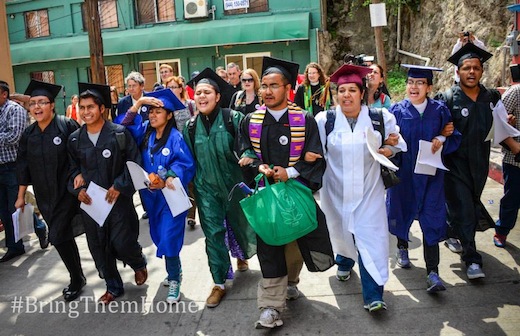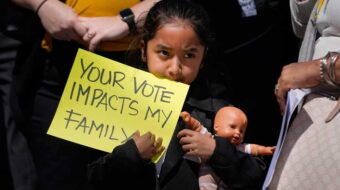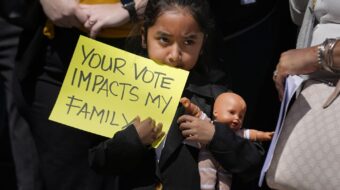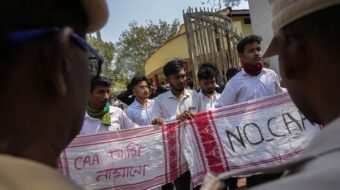
On July 22, Lulu Martinez and eight other undocumented youth who had grown up in the United States approached the U.S. port of entry in Nogales, Mexico to return home. They had traveled to Mexico, and then sought to return to the U.S. to dramatize the plight of 1.7 million families who have been separated as a result of mass deportations since 2009.
“We entered at Nogales where we asked for humanitarian parole, and to let us in because of all our ties,” said Chicago activist Lulu Martinez, a leader of the undocumented youth known popularly as the Dream 9.
They were arrested immediately and taken into custody. Thus began a 17-day fight for the right to return to the United States and be reunited with their families. After being granted humanitarian parole until their request for asylum can be heard, the Dream 9 were released.
Their request for asylum, on the grounds that their return to Mexico would endanger their lives, could take years to be acted on.
The bold action, organized by the National Immigrant Youth Alliance, attracted global attention and an outpouring of solidarity. It challenged the foundations of the immigration system and in the end may help recast the fight for immigration reform, setting a new precedent in the fight to reunify families.
Martinez, who lives in Chicago and attends the University of Illinois-Chicago, is no stranger to courageous action. She was one of 21 undocumented youth, likened by many to the Freedom Riders of the civil rights movement, who sat in congressional offices on Capitol Hill in July 2010 in support of the Dream Act.
The NIYA also organized a sit-in in the Arizona office of Sen. John McCain and at an Obama for America campaign office, and infiltration of immigrant detention centers.
All the Dream 9 participants first came to the U.S. from Mexico with their families when they were very young. Martinez left Mexico with her family at age 3 and hadn’t been back in 20 years. When she arrived in Mexico City on her return visit she saw some family members for the first time.
In every way but citizenship, these undocumented youth are American. By returning to Mexico, they risked permanent deportation, but felt they needed to do something dramatic to halt the 1,400 daily deportations of undocumented immigrants.
Three of the Dream 9, as undocumented young people living in the U.S., were eligible for President Obama’s Deferred Action for Childhood Arrivals (DACA) that gives undocumented youth legal status. But they insist that the same status be extended to their parents.
So, in protest against family separations, they “self-deported.”
They joined the six others who had left the U.S. over a year ago because of hardships caused by their status. These youth wanted to return to their families and communities in the U.S. even though they were not eligible for DACA.
“The day we were crossing the border many undocumented youth showed up who had heard about the action,” said Martinez. “We didn’t expect that, but we are in contact with them and working for more families to be reunited.”
The youth approached the border arm in arm, dressed in graduation caps and gowns. They were immediately arrested and taken to the Eloy Detention Center, in Eloy, Ariz. There they were thrown into cells with other detainees.
“The first couple of days we weren’t able to make calls to our attorney, family or friends. They accused us of not following instructions but they really wanted us to have limited contact outside and within the prison population,” said Martinez.
In response, one of the Dream 9, Maria Peniche, went on a hunger strike, which landed her in solitary confinement for five days.
A goal of the Dream 9 was to protest the conditions in the Eloy Detention Center itself. From similar actions at other detention centers they had gotten first-hand information on the conditions.
Martinez and another Dreamer passed out telephone numbers to the women inmates so they would have access to legal assistance.
“We were treated unjustly for this and so we started chanting, ‘undocumented and unafraid.’ For that we were slapped with a group demonstration charge and sentenced to eight days of solidarity confinement,” said Martinez.
Martinez described the conditions in the detention center as very bad. Some of the women with whom they shared their cells told of how they had been mistreated.
Often the water was contaminated and undrinkable and there was no air conditioning to alleviate the unbearable heat at the border.
The authorities took hours and days to respond to requests for medical assistance. One detainee had a painful knee injury and was neglected for most of a day, despite repeated pleas for help.
While the Dream 9 were in detention, a global solidarity campaign calling for their release was launched. Within days support mushroomed. It included gathering 29,000 signatures on a petition. Seven hundred organizations, 400 faith leaders and 42 members of Congress signed letters to President Barack Obama, calling for their release. And 900 people joined daylong solidarity hunger strikes.
With mounting public pressure, the Dream 9 won their release after 17 days. “It was really the mobilization of support on the outside that led to victory. There were so many people paying attention to it,” said Martinez.
Martinez believes many positive things resulted from the action beginning with the national conversation around their asylum claims.
“We weren’t the first. There were women in the detention facility who have been waiting for years on their asylum requests. They are living in fear and showed us their scars to prove it,” she said.
Martinez hopes the action will help put the spotlight on what has happened to those who are languishing in detention centers or who have been deported.
“We often talk about families being broken up in the U.S., but not about those who have been deported already,” she said. “We have raised the issue of real reunification with family members that have been deported. These questions are being asked out loud.”
The Dream 9 received a lot of support from their families. Martinez was especially thrilled by how active their mothers became in the fight to win their release.
Given the strength of anti-immigrant obstruction in Washington, Martinez is not confident of passage of reform legislation anytime soon. Even positive victories like DACA are being hampered. For example, many youth who are eligible can’t afford to pay the application fees, especially those who come from families with several brothers and sisters.
In addition to winning broad public support, Martinez is looking to build the power of the immigrant rights movement and particularly the activism of undocumented immigrant communities themselves.
“We needed to remind the immigrant community we also have to be agents of change,” said Martinez. “We learned we can work through the legal system but it comes down to pressure from the community that wins.”
“We have a broken immigration system and the bills in Congress don’t adequately address them,” she said. According to Martinez the first step is showing people there are multiple ways to fight.
“Everyone has access to tools and community support to get friends and family out of detention centers,” she said. “Our action crossing the border was big. Many people were paying attention. We have a lot of work to do.”
Photo: #bringthemhome/National Immigrant Youth Alliance












Comments